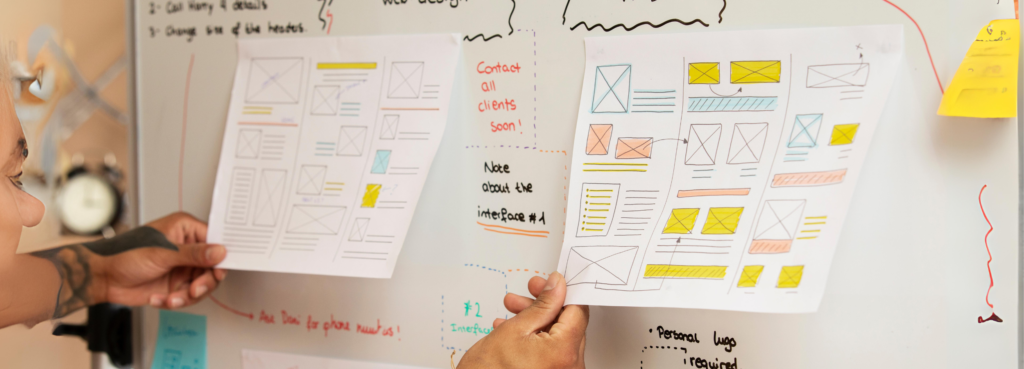Design Thinking 101: How It Affects Business Growth
Design thinking isn’t a new concept. The term was coined in the late 1960s. However, it gained significant traction in recent years, following the growth of what’s dubbed as a ‘design-led’ approach.
By prioritizing design, companies become inherently customer-centric. This shift in focus, from assumptions to understanding customer needs, is key to success.
A 10-year study by McKinsey found design-led companies “outperformed the S&P 500 by 219%.”
The Birth of Design Thinking
Nobel Prize laureate and cognitive scientist Herbert A. Simon was the first to mention design thinking as a way of thinking in his book The Sciences of the Artificial (1969). His contributions throughout the 1970s laid the foundations of design thinking and the design thinking process.
The Interaction Design Foundation (IxDF) defines design thinking as a “non-linear, iterative process that teams use to understand users, challenge assumptions, redefine problems, and create innovative solutions to prototype and test.”
In 1991, the company IDEO was founded and brought the design thinking concept to the main mainstream. Shortly after, Richard Buchanan published his article ‘Wicked Problems in Design Thinking.’
Fast forward to 2004, David Kelly founded the d.school.
It’s worth mentioning that many of the earlier references to ‘design thinking’ were in the fields of architecture and engineering.
When discussing design thinking, we must refer to the term ‘wicked problems,’ coined by design theorist Horst Rittel to describe “multidimensional and extremely complex” problems.
According to the IxDF, wicket problems are at the “heart of design thinking” because it is these “complex and multidimensional problems that require a collaborative methodology to gain a deep understanding of humans’ needs, motivations, and behavior.”
The design thinking process comprises five phases: Empathize, Define, Ideate, Prototype, and Test.
The 5 Stages of the Design Thinking Process
The first step of the designing thinking process is to Empathize. That is to research users’ needs to understand the problem. Through empathy, designers can set aside their assumptions and zoom in on their users and their needs.
Then, it’s time to Define those needs and problems using the data collected from the first step. Here the team should analyze the data and their observations to determine the core problems.
It is in this stage that a team may create buyer personas to maintain the human-centric approach. Statements or problems that arise from this stage are often referred to as ‘problem statements.’
The third step is to Ideate and brainstorm. The team needs to think outside the box to uncover solutions to the problem statements from step two.
The fourth step is to Prototype. This is an experimental phase where the team seeks to find the best solution to each problem. You may choose to create several versions with different features for your product so you can ‘Test’ them in the next stage.
Finally, it’s time to Test your prototype. However, since design thinking is considered iterative, this may not be your final stage. Whatever information or learnings you get from this stage, you may take back to the drawing board.
The results from the testing phase may even take you all the way back to the ‘Define’ stage, prompting you to move through several stages of the design thinking process all over again.
Also Read: Product-Led vs Sales-Led: Which Is Better for a Tech Startup?
The Secret Sauce
To grow and stay competitive, companies need to innovate. Design thinking helps with the innovation process, particularly in fast-growing environments.
Using design thinking, teams collaborate to dive deeper into customers’ or users’ needs to create solutions to solve those needs.
In addition, the end goal of using the design thinking process is to get a result that is ‘desirable, feasible, and viable.’
Research by McKinsey found “a strong correlation” between design thinking and business performance.
Companies that used design thinking processes were 32% more likely to grow their revenues and 56% more likely to increase the total returns to shareholders. That’s compared to companies that didn’t use design thinking. The research was conducted over a five-year period.
McKinsey’s research covered three main industries, namely medical technology, consumer goods, and retail banking.
Based on their research, McKinsey noted “the potential for design-driven growth [to be] enormous in both product- and service-based sectors.”
One example of design thinking and innovation can be seen with social media platform Instagram. In 2010, the company launched its initial product. But it didn’t stop there. Instagram’s founders focused on the app’s top features, that is image-sharing, likes, and comments.
They iterated and a few months later launched another version that resulted in 100,000 downloads in a week. In the course of two months, Instagram nabbed over 2 million users.
Another example is streaming service Netflix. With design thinking, Netflix transformed the entertainment industry by creating a personalized customer experience based on its viewers’ behaviors and preferences.
Netflix used data analytics and machine learning to see customers’ viewing patterns and create recommendations to cater to those patterns and tastes.
Turning to the prototyping and testing phases in the design thinking process, Netflix experimented with various features such as the skip intro option.
Also Read: 7 Ways to Future-Proof Your Business in 2024 and Beyond
How to Navigate Market Disruptions with Design Thinking
Despite its name, design thinking should not be limited to a single team or department. Design thinking fosters innovation. It helps teams improve their internal communication, increases collaboration, and ultimately translates to better results for the product and the whole company.
In other words, design thinking should be part of a company’s corporate culture.
When different teams get together to brainstorm, they can produce more solutions and ideas to ensure the product meets customers’ needs better.
Design thinking can help product owners, software engineers, designers, and sales and marketing teams see problems from different perspectives. It also helps different teams get into the customers’ shoes to get a better understanding of the personas and their pain points.
By focusing on customers’ needs, the design thinking methodology helps different teams uncover pain points and use them to improve the product and their communication with stakeholders and customers.
Instead of focusing on assumptions, design, product, and tech teams can experiment, brainstorm, and ask questions. Together they have a better chance of creating a better minimum viable product framework and a go-to-market strategy.





